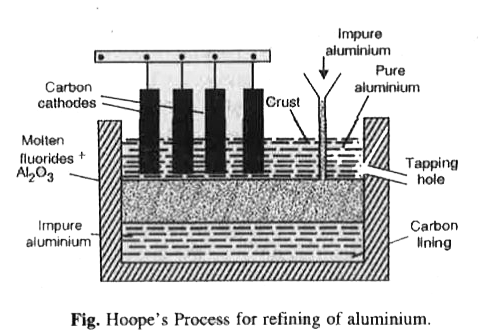Why is cryolite added to alumina ? Give Hoope's electrolytic process of refining of aluminium.
Text Solution
Cryolite is added to alumina to lower its melting point and to increase its conductivity.
Hoope.s Electrolytic process of refining of aluminium
Aluminium, is refined in an iron-tank lined at the bottom with carbon. Three layers of aluminium having different specific gravities are placed in the tank. The bottom layer having specific gravity 3.0 g/cc consists of impure aluminium in the molten form and it serves as anode. Middle layer consists of fluorides of Al, Ba and Na has specific gravity 2.8 g/ce. The top layer consists of pure molten aluminium and has specific gravity 2.3 g/cc. This serves as cathode.

On passing electric current aluminium from middle layer goes to the top layer and same amount of aluminium from bottom layer passes to the middle layer. Pure aluminium is removed from the top by an outlet and impure molten aluminium is added from time to time.
|
Topper's Solved these Questions
- GENERAL PRINCIPLES AND PROCESSES OF ISOLATION OF ELEMENTS BOOK - MBD -HARYANA BOARDCHAPTER - GENERAL PRINCIPLES AND PROCESSES OF ISOLATION OF ELEMENTS EXERCISE - SHORT ANSWER TYPE QUESTIONS
21 Videos
- ELECTROCHEMISTRYBOOK - MBD -HARYANA BOARDCHAPTER - ELECTROCHEMISTRYEXERCISE - LONG ANSWER TYPE QUESTIONS
12 Videos
- HALOALKANES AND HALOARENESBOOK - MBD -HARYANA BOARDCHAPTER - HALOALKANES AND HALOARENESEXERCISE - LONG ANSWER TYPE QUESTIONS
10 Videos
Similar Questions
Knowledge Check
Hoope's process is used in the refining of
AAlBZnCAgDCuCryolite is used in the electrolytic extraction of aluminium
Ato obtain more aluminiumBto dissolve bauxiteCto protects anodeDas a reducing agentCryolite is used in the electrolytic extraction of aluminium
Ato obtain more aluminiumBto dissolve bauxiteCto protects anodeDas a reducing agent
Explain the role of cryolite in the electrolytic reduction of alumina.
View SolutionExplain the role of :
Cryolite in the electrolytic reduction of alumina.
View SolutionWhat is the role of cryolite in the extraction of pure aluminium from bauxite by electrolytic process?
View SolutionDuring Hoope's process for electrolytic refining of Al, the middle layer is of
View Solution(A) Alumina has hgih condutivity
(R ) The mixture of alumia and cryolite is used for electrolytic reduction in order to extract aluminium
View Solution
